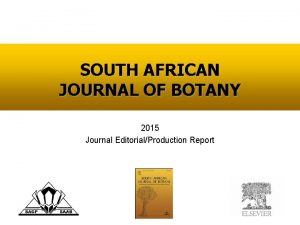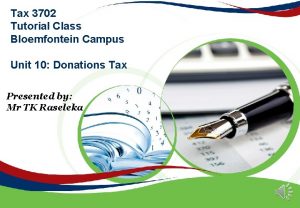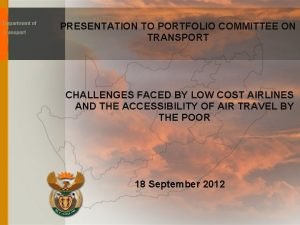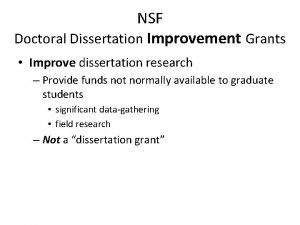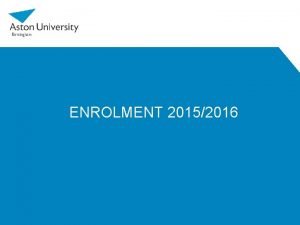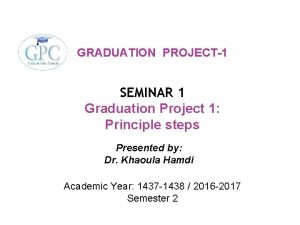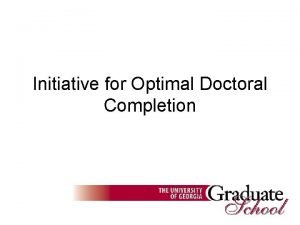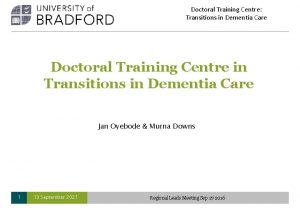Knowledge Seminar South African doctoral enrolment graduation and
























- Slides: 24

Knowledge Seminar: South African doctoral enrolment, graduation and demographics February 2012

Doctoral enrolments, doctoral graduates and research publications Graph 1 sets out data on key elements of SA’s high-level knowledge production for the period 1996 -2010 expressed as doctoral enrolments, doctoral graduates and research publication units. Average annual changes in these totals are reflected in Graph 2. 2

Average annual changes: enrolments, graduates and publications Graph 2 divides Graph 1 growth rates into the period between (a) 1996 and 2002, which covered the period of the 1997 HE White Paper and the 2001 National Plans, and (b) 2004 -2010 which covered the introduction and implementation of the new 2003 government funding framework. 3

Doctoral enrolments by race group Graph 3 divides the doctoral enrolment totals for 1996 -2010 into race groupings. The main change has been in African doctoral enrolments, which increased from 663 in 1996 to 5066 in 2010, when African doctoral enrolments exceeded that of White enrolments for the first time. 4

Percentage of doctoral enrolments in race groupings Graph 4 shows how the % of doctoral enrolments by race group changed between 1996 to 2010. African doctoral students rose from 13% in 1996 to 33% in 2004, and 44% in 2010. 5

Graduation rates and cohort output equivalents Graph 5 offers a first picture of the doctoral output efficiency of SA’s public HE system, based on output ratios which appear in the 2001 National Plan. The National Plan set this as an output norm: • • The ratio between doctoral graduates in a given year and doctoral enrolments should = 20%. So, if 10 000 doctoral students were enrolled in the HE system in year X, then at least 200 of these students should graduate in year X. This norm was based on a further target norm that at least 75% of any cohort of students entering doctoral studies for the first time in (say) year Y, should eventually graduate. Calculations had shown that if the cohort output norm was to be achieved, then the 20% ratio of total graduates to total enrolments would have to be met over a period of time. 6

Graduation rates and cohort output equivalents Graph 5 shows that, as far as doctoral outputs are concerned, the Public HE system has failed to meet the National Plan’s efficiency targets. Calculations show that over the period 1996– 2002, less than 50% of students entering doctoral programmes in SA will eventually graduate. 7

Actual doctoral graduates vs normative totals on National Plan target ratio Graph 6 offers estimates of the effects of inefficiencies in SA’s doctoral programmes. For example, over the period 2005 -2010, SA should, on the National Plan’s norms, have produced a total of 12 285 doctoral graduates but in fact produced only 7 711, leaving a “shortfall” of 4 739 graduates (who would have been drop outs from the system). 8

Doctoral degree cohorts (2001, 2002, 2003): Average dropout & graduation by Race New entrants Race 2117 African Academic year Registered at beginning of year Year 1 Year 5 Total graduates & dropouts for cohort *Year 7 2117 665 281 26 655 860 41% 1257 59% Graduated (Cumulative) Dropped out (Cumulative) 606 1017 274 Registered at beginning of year 274 119 4 91 130 47% 45 108 144 53% 555 193 101 4 202 254 46% 116 216 301 54% 3040 1034 58 1213 1523 50% 538 1158 1517 50% 5986 2011 92 2161 2767 46% 1305 2499 3219 54% Coloured Graduated (Cumulative) Dropped out (Cumulative) 555 Registered at beginning of year Indian Graduated (Cumulative) Dropped out (Cumulative) 3040 Registered at beginning of year White Graduated (Cumulative) Dropped out (Cumulative) 5986 Registered at beginning of year Total Graduated (Cumulative) Dropped out (Cumulative) • 441 867 The End of year 7 dropping out numbers also include students that may have registered in future years to complete their studies. Source: DHET. 2011, CHET Ph. D analysis

Doctoral degree cohorts (2001, 2002, 2003): Average dropout & graduation by University Group New entrants 3098 Academic year Year 1 Year 5 Total graduates & dropouts for cohort *Year 7 High Productive Universities : University of Cape Town, University of Pretoria, Rhodes University, University of Stellenbosch, University of the Witwatersrand Registered at beginning of year Graduated (Cumulative) 3098 1230 29 1179 509 1532 49% 495 1130 1566 51% Dropped out (Cumulative) Other Universities : University of Fort Hare, University of the Free State, University of Limpopo, North-West University, University of the Western Cape 978 Registered at beginning of year Graduated (Cumulative) 978 10 316 372 144 485 50% 210 388 493 50% Dropped out (Cumulative) Comprehensive Universities : University of Johannesburg, Nelson Mandela Metropolitan University, University of South-Africa, University of Venda, Walter Sisulu University, University of Zululand 1702 Registered at beginning of year Graduated (Cumulative) 1702 407 187 50 554 672 39% 530 869 1030 61% Dropped out (Cumulative) Universities of Technology : Cape Peninsula University of Technology, Central University of Technology, Durban University of Technology, Mangosuthu University of Technology, Tshwane University of Technology, Vaal University of Technology 208 Registered at beginning of year Graduated (Cumulative) Dropped out (Cumulative) 208 3 58 56 27 78 70 112 130 5986 2011 867 92 2161 2767 46% 1305 2499 3219 54% 78 38% 130 63% Total 5986 Registered at beginning of year Graduated (Cumulative) Dropped out (Cumulative) Source: DHET. 2011, CHET Ph. D analysis

100% 90% 80% South African – Ph. D graduates by South. Universities African Internationality 29% 30% 34% 71% 70% 66% 70% 60% 50% 40% 30% Enrolments South African International 2007 7 195 2 853 2008 6 959 3 035 2009 7 213 3 316 2010 7 841 3 749 Graduates South African International 2007 900 374 2008 829 353 2009 908 470 2010 931 489 South African Ph. D students graduation rate by nationality South African International 20% 15% 0% 14% 90% 2007 2008 2009 2010 Norwegian Universities - Ph. DInternational graduates by nationality Norwegian 23% 80% 25% 26% 28% 33% 70% 60% 50% 40% 77% 30% 75% 74% 72% 67% 20% 10% 0% 2007 2008 2009 2010 2011 Graduation Rate 10% 100% Total 10 048 9 994 10 529 11 590 Total 1 274 1 182 1 378 1 420 13% 14% 13% 12% 11% 13% 12% 2007 2008 2009 2010 It is important to note that the two countries produce almost the same number of Ph. D graduates but that South Africa’s population is in the order of 48 million whilst Norway’s population is 4. 8 million Graduates Norwegian 2007 789 2008 937 2009 851 2010 858 2011 889 International 241 308 297 326 438 Total 1030 1245 1148 1184 1327

Permanent academic staff Academic staff with doctoral degrees are a key input for high-level knowledge production is. Permanent academic staff in this category should be the major producers of research outputs, and at an input level the main supervisors of doctoral students. Graph 7 shows how the totals of permanent academic staff with doctoral degrees changed between 1996 and 2010. 12

Percentage of academic staff with doctorates by institutional category Graph 8 divides public HE institutions into the 3 categories used for national planning purposes, and sub-divides the 11 universities into a group of 6 which produces 60% of the HE system’s total high-level knowledge products and the remaining 5. The groups are: High productive universities UCT, UKZN, Pretoria, Rhodes, Stellenbosch, Wits Other universities Fort Hare, Free State, Limpopo, North West, UWC Comprehensive universities UJ, NMMU, Unisa, Venda, WSU, Zululand Universities of technology Cape Peninsula, Central, Durban, Mangosuthu, Tshwane, Vaal DUT 13

Percentage of academic staff with doctorates by institutional category Graph 8 14

Ratios of doctoral enrolments to academic staff with doctorates The low proportions permanent academic staff with doctoral degrees must have an impact on the numbers of doctoral students which can be enrolled and supervised. Graph 9 shows what the ratios have been between doctoral enrolments and permanent academic staff with doctorates. A ratio of two doctoral enrolments permanent academic with a doctorate could be used as an indicator of institutional capacity. Graph 9 shows that the high productive group of universities and the comprehensives had ratios above 2 in 2010, which could be taken to imply that they have reached capacity as far as doctoral enrolments are concerned. Increases in their doctoral enrolments should depend on more academic staff obtain their own doctoral degrees. The 2: 1 norm suggests that the other group of 5 universities and the universities of technology may have spare supervisory capacity, but their ability to deal with this depends on their current financial and efficiency levels. 15

Ratios of doctoral enrolments to academic staff with doctorates Graph 9 16

Government research funding allocations by output category and financial year Government’s funding incentives for research outputs are complex because of the 2 -year time lag between the completing of an output and the receipt of a funding allocation, and the weightings applied to research outputs. Graph 10 shows what research funding totals were generated by each output category. Graph 11 shows what the Rand values can be assigned to research output units. 17

Government research funding allocations by output category and financial year Graph 10 18

Estimates of Rand values of research outputs Graph 11 19

Average annual increases in outputs It could be argued that the high Rand values for doctoral graduates should have functioned as strong incentives to institutions to expand these outputs. The data in Graph 12 suggest these financial incentives have not yet affected doctoral graduate growth, which was 3. 5% pa between 2000 & 2004, and 3. 6% pa between 2005 and 2010. There are likely to be a number of reasons why doctoral graduate totals have not yet responded to the output funding incentives introduced for the first time in the 2004/5 financial year. One explanation is that only a few universities have been able to benefit from the introduction of government research output incentives. A second explanation is that doctoral processes in SA have been characterised by high levels of inefficiency, as has been seen in Graphs 5 and 6. 20

Average annual increases in outputs Graph 12 21

Total government research output funding permanent academic Graph 13 shows that government output funding can be related to staff capacity. In 2011/12 the high productive university group generated R 290 000 in government research funds permanent academic, which was considerably higher than the averages for the other groupings. 22

Doctoral and publication output funding permanent academic in 2011/12 Graph 14 relates doctoral graduate funding to permanent academic staff, but also compares this doctoral funding to research publication funding permanent academic. The graph shows that in 2011/12 the high productive universities group generated R 82 000 in doctoral funding permanent academic, and R 126 000 in research publications. The amounts are lower, but similar wide differences can be seen in the other institutional categories. These lower amounts generated by doctoral graduates could be related to institutional inefficiencies, but also to institutional incentives. Some institutions distribute publication output funds to authors, but few (if any) distribute doctoral graduate funds to supervisors. Academic staff members are therefore likely to gain more direct personal benefits from research publications than from doctoral graduates. 23

Doctoral and publication output funding permanent academic in 2011/12 Graph 14 24
 South west doctoral training partnership
South west doctoral training partnership Doctoral initiative on minority attrition and completion
Doctoral initiative on minority attrition and completion Hamilton the surgeon
Hamilton the surgeon Saaqis
Saaqis Safi south africa
Safi south africa South african journal of botany impact factor
South african journal of botany impact factor Naairs south africa
Naairs south africa The south african apartheid
The south african apartheid South african bont tick
South african bont tick South african tax
South african tax Sacap architectural compliance certificate
Sacap architectural compliance certificate South african freedom charter pdf
South african freedom charter pdf South african tax
South african tax The great escarpment map
The great escarpment map South african council for natural scientific professions
South african council for natural scientific professions South african principals association
South african principals association South african transport conference
South african transport conference Seamless southern africa
Seamless southern africa Eui doctoral programme
Eui doctoral programme Abd dissertation
Abd dissertation Nsf dissertation improvement grant
Nsf dissertation improvement grant Umbc doctoral programs
Umbc doctoral programs College doctoral ubfc
College doctoral ubfc Power point tesis doctoral medicina
Power point tesis doctoral medicina Nsf biological anthropology ddrig
Nsf biological anthropology ddrig





